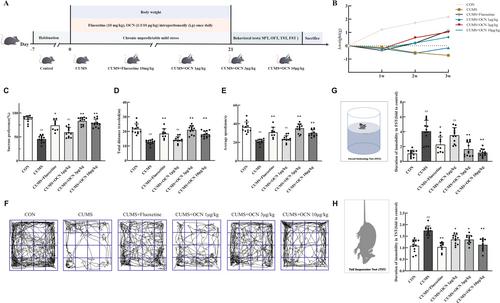Osteocalcin Ameliorates CUMS-Induced Depressive-Like Behaviors by Reducing Mitochondrial Damage in Hippocampal Neurons
Abstract
Background
Depression is a common psychological disorder characterized by limited treatments. Osteocalcin (OCN), a bioactive protein that originates from bone tissue, has been implicated in emotional regulation and the reduction of oxidative stress in peripheral tissues. However, the precise mechanisms by which OCN functions within the central nervous system are still not fully understood.
Aims
This study aimed to clarify the function of OCN in depression-like behavior, identify its functional brain region, and explore its impact on neuronal mitochondrial function and the exact molecular mechanisms involved.
Materials and Methods
In this study, the antidepressant effects and mitochondrial protective properties of OCN were examined in adult male C57BL/6 mice subjected to chronic unpredictable mild stress (CUMS); then, the potential molecular pathway was explored both in vivo and in vitro conditions. The CUMS model was employed to induce depression in mice. Initially, depressive-like behaviors in CUMS mice were evaluated following a 3-week intraperitoneal injection of OCN. Subsequently, the expression levels and distribution of GPR158 and GPR37 were examined. Next, the specific effects of OCN on mitochondrial function were determined. Finally, the molecular pathways through which OCN demonstrates its antidepressant properties and offers mitochondrial protection were explored in both in vivo and in vitro conditions.
Results
OCN significantly alleviated depressive-like symptoms in CUMS mice, which was evidenced by improvements in weight variations, increased consumption of sucrose, and a greater total distance traveled in the open field test (OFT). Additionally, it shortened the immobility time observed in both the forced swim test and the tail suspension test. OCN influenced hippocampal neuronal activity by modifying the expression levels of PR158 and GPR37, demonstrated by its ability to counteract the downregulation of both receptors in experiments conducted in vivo and in vitro. Furthermore, OCN mitigated mitochondrial damage in neurons induced by depression through the PKA/AMPK/PGC1α signaling pathway, resulting in elevated ATP levels and reduced ROS levels. Notably, inhibiting PKA and AMPK abolished OCN's effects on PGC-1α, ATP production, and ROS reduction.
Discussion
The administration of OCN significantly ameliorates depressive-like behaviors in mice, demonstrating the crucial involvement of the bone-brain pathway in depression pathogenesis and offering further evidence for a better understanding of how peripheral bone tissue affects brain function. The results also provide a novel perspective on the function of OCN in neurons, paving the way for further exploration of innovative therapeutic approaches for central nervous system disorders associated with mitochondrial dysfunction.
Conclusion
Our results indicate that OCN mitigated oxidative stress damage and enhanced mitochondrial function through the AMPK/PGC-1α pathway, demonstrating antidepressant properties.


 求助内容:
求助内容: 应助结果提醒方式:
应助结果提醒方式:


